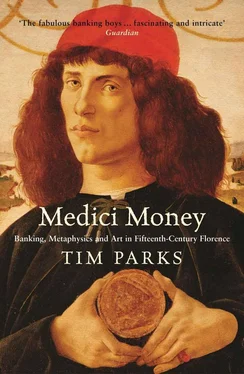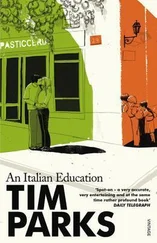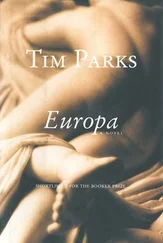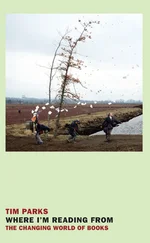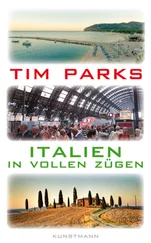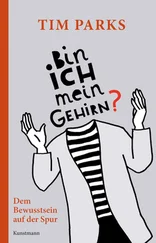THE TALE OF Giovanni XXIII’s vicissitudes — his four-year imprisonment, the Medici’s remarkable loyalty to him, his bequest to them of the sacred finger of John the Baptist, their payment of 3,500 florins to ransom him, his assignment to them of his collection of rare jewels, their successful intercession with Martin V (after returning to the Curia a certain fabulously bejeweled mitre) to have their friend named on his release, whores and heresies forgotten, bishop of Tusculum (Frascati) — all this would be story enough to fill a book. Yet often it is not the obvious melodrama that really changes things, nor even the bewildering back-and-forth of money and sacred objects, but something quite different, apparently innocent. What mattered most in this tale — for the Medici, their bank, for Florence, and arguably, as we shall see, for us too — was Baldassarre/Giovanni’s funeral monument. For in 1419, six months after he was ransomed, the ex-pope coughed up, in Cosimo de’ Medici’s house, that final debt whose payment you can only put off for so long.
Let us return for a moment to the first story of the Decameron . Ser Ciappelletto, notorious liar, cheat, fornicator, murderer, and sodomist (the list begins to look familiar), a notary by profession, is sent to a foreign country to do some debt collecting. He lodges with the local Italians, who, true to the nation’s international vocation, are usurers. He falls mortally ill. They are terrified: if their guest doesn’t confess, he will be denied burial; if he does, the scandal of the company they are keeping will offer local people the excuse they are looking for to lynch them for their usury. But Ser Ciappelletto has a solution. He confesses himself, yet claims to remember no worse sins than having once spat in church and once cursed his mum when he was a little boy. No, he never lent money at an interest. No, he never had sex with anyone. He preserved his virginity. Convinced the man is a saint, the priest has him buried in the local convent, where his tomb becomes an object of frenetic popular devotion; those who pray over it claim miraculous results.
The comedy of the story depends on the absolute clarity of the underlying theology and metaphysics. This world is a trial for the next. Death is the day of reckoning, after which it is hell or heaven (purgatory being just a more or less extended annex of the latter). To tell lies, then, in a final confession is madness. It turns the world upside down. Ser Ciappelletto is quite brilliant in the way he resolves an earthly problem, but utterly blind because he does so at the expense of his soul. He is going to burn. Human astuteness, which is so seductive, so funny, has no place in a vision that divides the world into good or bad and sees no space between.
It is precisely this clarity, then, and people’s complete conviction in it (atheism is unimaginable), that leads to all the equivocation when it comes to describing complicated financial activities. For everything must be declared a sin or not a sin. “He who is not for me is against me,” Christ said. In the Baptistery, Florence’s oldest, most central church, a Last Judgment divided the domed ceiling into the blessed and the damned. Nothing else. The rigid, static Byzantine style, the hard little stones of the mosaic, allowed for no confusion, or even diversion. The image is its message. The beauty of color, line, and gesture only increases the clarity. For me or against me. Your fate. What could a banker do?
We know nothing of Giovanni di Bicci’s childhood. Presumably, like other middle-class youngsters, he was signed on at a guild in his teens and was working in his uncle’s bank as an adolescent. But for his sons he chose a more sophisticated education, first at a monastery school, then under the supervision of Roberto de’ Rossi, a humanist from a patrician family, a man who introduced the young Cosimo and his brother Lorenzo to other more celebrated early humanists, Poggio Bracciolini, Leonardo Bruni, Niccolò Niccoli, and Ambrogio Traversari — men who instilled in the young banker a passion for the pre-Christian, classical world, and above all for finding, collecting, and even reading the manuscripts through which that world could be known. So while Cosimo was at the Church Council in Constance, and hence skipping his regular discussion groups with these men, he could enjoy the company of Poggio Bracciolini, who was present as secretary to Giovanni’s papal court and who took time out from his duties to visit the monasteries of Cluny and St. Gallen, where he uncovered various forgotten manuscripts of Cicero and Quintilian. About these much could be said, but for the essential, though rarely declared, inspiration that lies behind early humanism, we can go back a generation and read Boccaccio’s preface to his compendium book, De mulieribus claris , “About Famous Women.” “I have decided to exclude Christian women,” Boccaccio begins apologetically. Of course they are “resplendent in the true and unfailing light,” but, “their virginity, purity, holiness and invincible firmness in overcoming carnal desire” have already been amply praised “by pious men outstanding for their knowledge of sacred literature.” So I am going to turn elsewhere, Boccaccio tells us, to the pre-Christian world.
Christianity is duly acknowledged and revered, so that then we can concentrate elsewhere — on the women of Rome, the literature of Greece, on human qualities and values that have nothing to do with religion. This, more than any particular content, is the sense of humanism: to carve out a space that need not be understood in the urgent and inconvenient tensions of Christian metaphysics — heaven or hell — while still remaining within the Christian world. Dogmatism is abandoned, but not the faith. Is it really okay, Boccaccio had asked his mentor Petrarch some years before that preface, for a Christian to spend so much time with profane literature? So long, Petrarch assures him, as the literature is instructive, educates the young to serve the community, and turns the soul toward beauty and truth. This is the breakthrough: the idea of a secular space where one can have such moral values, but independently of Church teaching. What would-be honest banker dealing in dry exchanges would not yearn for such a thing, would not contribute to a culture that recognized other qualities than strict adherence to canon law? It is the space we live in today. Much of it was first staked out in fifteenth-century Florence.
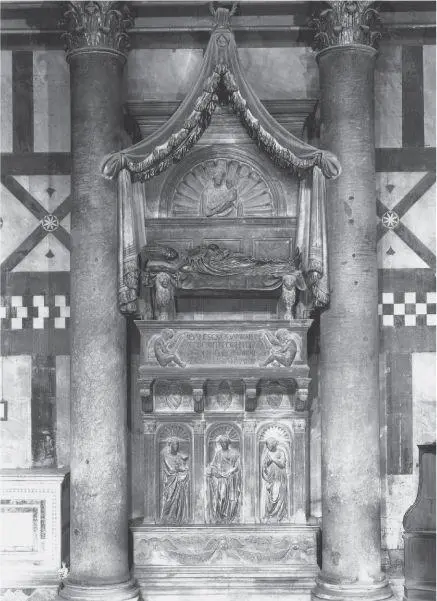
Tomb of Pope (or anti-pope) Giovanni XXIII, commissioned by Cosimo de’ Medici from Donatello and Michelozzo, in the Florence Baptistery. Warned not to disturb the Byzantine austerity of the space, the architects built upward rather than outward, but lavishly. The sculpted words, IOHANNES XXIII QUONDAM PAPA (“John XXIII, erstwhile Pope”), offered disturbing food for thought for Florentine worshippers .
In the medium of writing, creating this territory must have seemed easy enough: one rediscovered the literature of Rome and later Greece, made new copies, discussed it, wrote books about it. But the visual arts were almost entirely devotional in nature. How would the secular ever find some elbow room here? Slowly, is the answer, by stealth. The Medici played their part.
Of the four illustrious men appointed as executors of Baldassarre/Giovanni XXIII’s will, one was his banker, Giovanni di Bicci. The ex-pope wanted to be buried in the Baptistery, the oldest, the most holy place of worship right in the center of Florence. Only three other bishops had ever been buried there, and only in the simplest and sparest of stone boxes. Decoration on the walls was a rigid black-and-white marble patterning. Nothing must distract attention from the final division of the blessed and the damned on the ceiling.
Читать дальше
